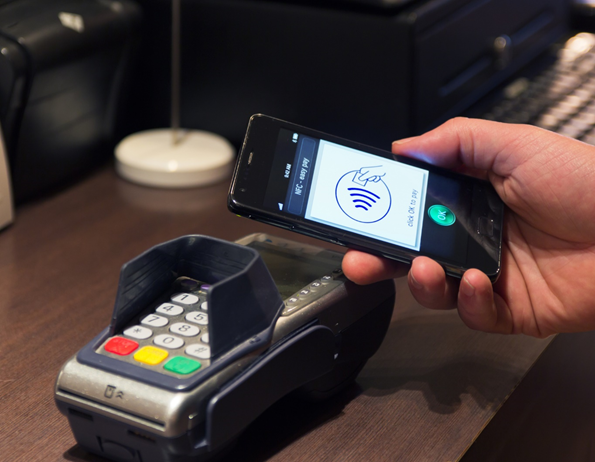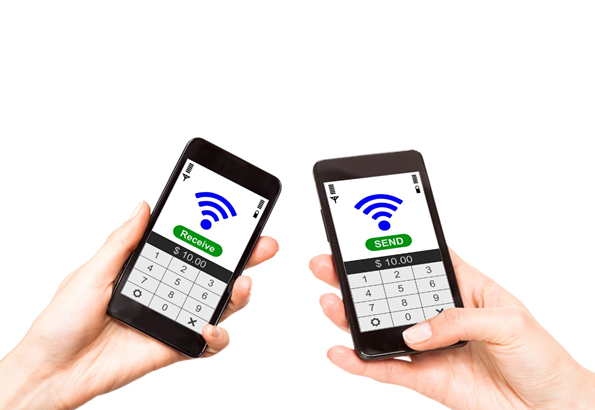What is Near Field Communication?
Near Field Communication (NFC) refers to the contactless or short-range wireless technology that allows the transfer of the data between two NFC-enables devices. Using NFC technology, it is possible to make smartphones, wearables, payment cards, tablets, and many other smart devices smarter. Through NFC, you could even transfer data at a faster rate with a single touch.

Source: © Audioundwerbung| Megapixl.com
Evolution of NFC
NFC is a new short-range wireless connectivity technology that evolved from the integration of contactless identification and interconnection technologies.
- The first patent related to the Radio Frequency Identification Technology (RFID) was given to Charles Walton in 1983. The patent related to the concept of Radio Frequency powered transponder was filed in 1970, and the patent was granted in 1973 to M. Cardullo and W. Parks.
- In March 2002, Sony and Phillips provided the force to progress NFC field by joining forces to determine specifications.
- In 2004, Sony, Nokia and Phillips founded NFC Forum to progress the development and implantation of NFC. This forum creates requirements that confirm the interoperability of the NFC components.
- In 2006, the first device with NFC functionality was introduced by Nokia under the product model Nokia 6131.
- In 2010, Samsung became the first company to introduce Android with NFC Support. The product was Samsung Nexus S.
- In 2011, RIM was the first company to be certified by MasterCard to provide the PayPass functionality on their devices globally.
- In 2013, Samsung and Visa entered into a partnership to develop mobile payment.
- In 2015, Apple introduced NFC to its iPhone 6 and iPhone 6 plus. The NFC application was limited to mobile payment.
How does Near Field Communication work?
Near Field Communication allows data transmission via electromagnetic radio field that allows two devices to communicate. It is essential to know that two devices using this technology can communicate with each other if they are NFC-enabled or simply, we can say that the devices have NFC chips.

Source: © Scyther5| Megapixl.com
Advantage of NFC over Bluetooth technology
Both NFC and Bluetooth technology allow two devices to communicate with each other. However, there are certain advantages of NFC over Bluetooth. Let’s look at the key advantages.
- In Bluetooth technology, the two devices need to be paired to communicate or transfer data. However, in the case of NFC technology, devices pairing is not required. The connection between the two devices gets automatically established once they come close in the communication range.
- As NFC communicates in a shorter range, there is a high-security level compared to the Bluetooth technology.
- NFC also works even if one of the devices is not powered by a battery. An example of this is a contactless smart credit card.
- NFC requires less power as compared to the Bluetooth technology.
What are the types of NFC devices?
NFC devices are classified into two types- Passive NFC devices and Active NFC devices.
Passive NFC devices
Passive NFC devices comprise tags or small transmitters that send information without any power source requirement. These devices do not process any information that is sent from other sources. Besides, these devices cannot connect to other passive components.
Active NFC devices
Active NFC devices can send as well as receive data. They are capable of communicating with both active and passive NFC devices. An example of an active NFC device is a smartphone. Another example of active NFC device is a card reader most commonly used when one is travelling using a public transport.
What are the different modes of operation?
At present, there are three different modes of operation to determine the type of information that would be exchanged between the devices. These are:
- Peer-to-peer mode: In peer-to-peer mode, the exchange of information is allowed between two devices. The most common example is a smartphone. In this mode, both devices switch between active when they send data and passive while they are receiving data.
- Read-write mode: In this mode, one of the NFC-enabled devices links with the other to read information. Here, the active device is probably a smartphone. In this mode, advertisement tags are used.
- Card emulation: In card emulation, the NFC device can operate as a smart or a contactless credit card. These are capable of making payments or can be used in public transport systems.
Application of Near Field Communication
Near field communication has multiple applications. Let us look at them in detail.
Smart Cards
Making a payment using a smart card (NFC enabled) makes payment easy compared to the traditional multiple-step payment process. An example of this the payment services like Visa and MasterCard. These companies are offering smart cards to their customers.
These cards help customers to make faster payment to different stores, restaurants, parking tickets and many more.
E-Wallet
Nowadays, we are familiar with the term e-wallet. Most of the transactions are now taking place cashless, thus, making payment more convenient for customers. Here, the payment can be made using a simple tap or through waving the card within the close vicinity.
You might have also seen many service providers integrating payment option into smartphones via NFC embedded tags inside the device. Some of them are Apple pay, Samsung Pay etc.
Smart Ticketing
NFC technology has made it possible for customers to replace the conventional ticket system with smart tickets. These smart tickets can be used for purchasing airlines tickets, train tickets, bus tickets. Customers are now able to use these smart tickets for purchasing movie tickets, concert tickets etc.
Medicine and Healthcare
The role of NFC technology can be seen in the field of healthcare and medicine. NFC technology allows better communication between the medical practioners and patients. These medical practioners helps them to remain updated.
Eliminate the need for keys
In the present time, we might have seen in many places where NFC technology is used for opening the doors. A most common example here is the cards use for opening the hotel rooms.
NFC and RFID are being used for entering the door or places with restricted entry.
Manufacturing
Near Field Communication helps manufacturing firms furnish their products, parts, tools as well as a machine with NFC tags. NFC tags help in identifying each product from its distinct procedure phases within the Firm. Because of the unique identification number, it is possible for the manufacturers to effectively handle the product in case of any situation like replacement, packaging, transportation etc.
Inventory management
NFC technology has an important role to play in the fields of inventory management. Big retail shops and supermarkets use smart RFID tags to manage the inventories in the system. Using smart inventory management software, it would be possible for them to have a real-time update on the customers’ product details. The products are available at the store and in the current inventory. The best part here is that, through this NFC technology, the store gets an alert in case of low quantity.
Protection from theft
When any product has RFID tags, it is possible to protect it from theft. In case a person tries to steal a product with embedded smart tags and passes RFID vicinity, it would get triggered immediately.
Better Robotics
In present times, robotics is becoming popular gradually. Robotics has a key role to play in manufacturing. In the manufacturing sector, these NFC tags help the robots to carry out the process effectively. Robots would be able to tell the correct components and tools that would be needed to do a particular task. By this, these manufacturing units would reduce the production of any faulty or damaged product.
Future of NFC
We have seen the usage of NFC in our day to day life. However, NFC will have a much broader scope in the near future. In the upcoming period, the application of NFC could be seen in the below-mentioned fields:
Smart Home
Because of NFC and RFID, we would be able to personalise and program application via a smartphone. Once the NFC tags get activated, it is possible to control the different types of equipment, door access, set the alarm or execute any other household-related work via the smartphone.
IoT and 5G
Days are not far when we see the application of NFC in IoT and 5G technologies. IoT and 5G will bring new prospects for new technologies to emerge. Hence, there are possibilities that NFC technologies would be needed in IoT and 5G-enabled network to get the work done efficiently and easy implementation.
Advantage and Disadvantage of NFC
Advantage of NFC
- It makes the process of making payment easy along with other transactions via mobile wallet.
- It can be used in fields of banking, ticketing etc.
- Allow secure entry to the authorised person within the premises.
- It is more secure than the magnetic stripped credit or debit card.
- There is no requirement for any search and pair procedure for the device to communicate. Instead, when NFC enabled devices comes in close vicinity, they automatically establish connectivity.
- It is friendly with the prevailing RFID networks.
The Disadvantage of NFC
- The biggest drawback with the NFC technology is that it works when the devices are in close proximity in between 10 to 20 cms.
- The rate at which the data gets transferred from one device to another is relatively slow compared to other technologies.
- NFC enabled devices are pretty expensive.
- Though NFC technology is safer than magnetic strip-based credit and debit card, one cannot assure that it is 100% risk-free. Devices being able to communicate at small distances, mobile data may get hacked.
- NFC devices consume more power.
 Please wait processing your request...
Please wait processing your request...